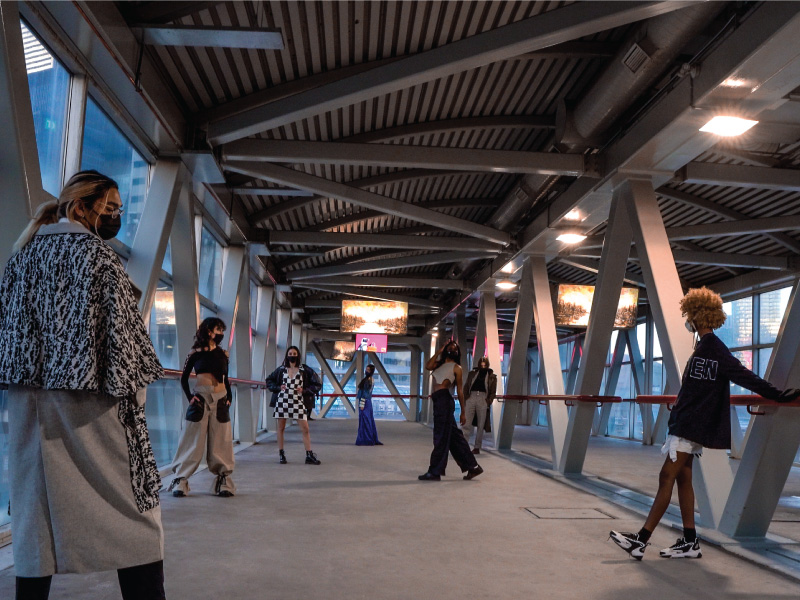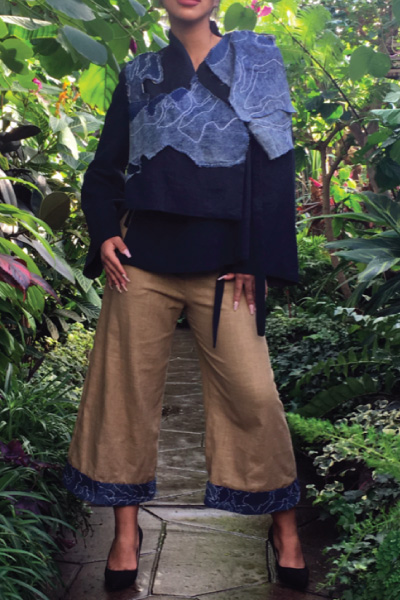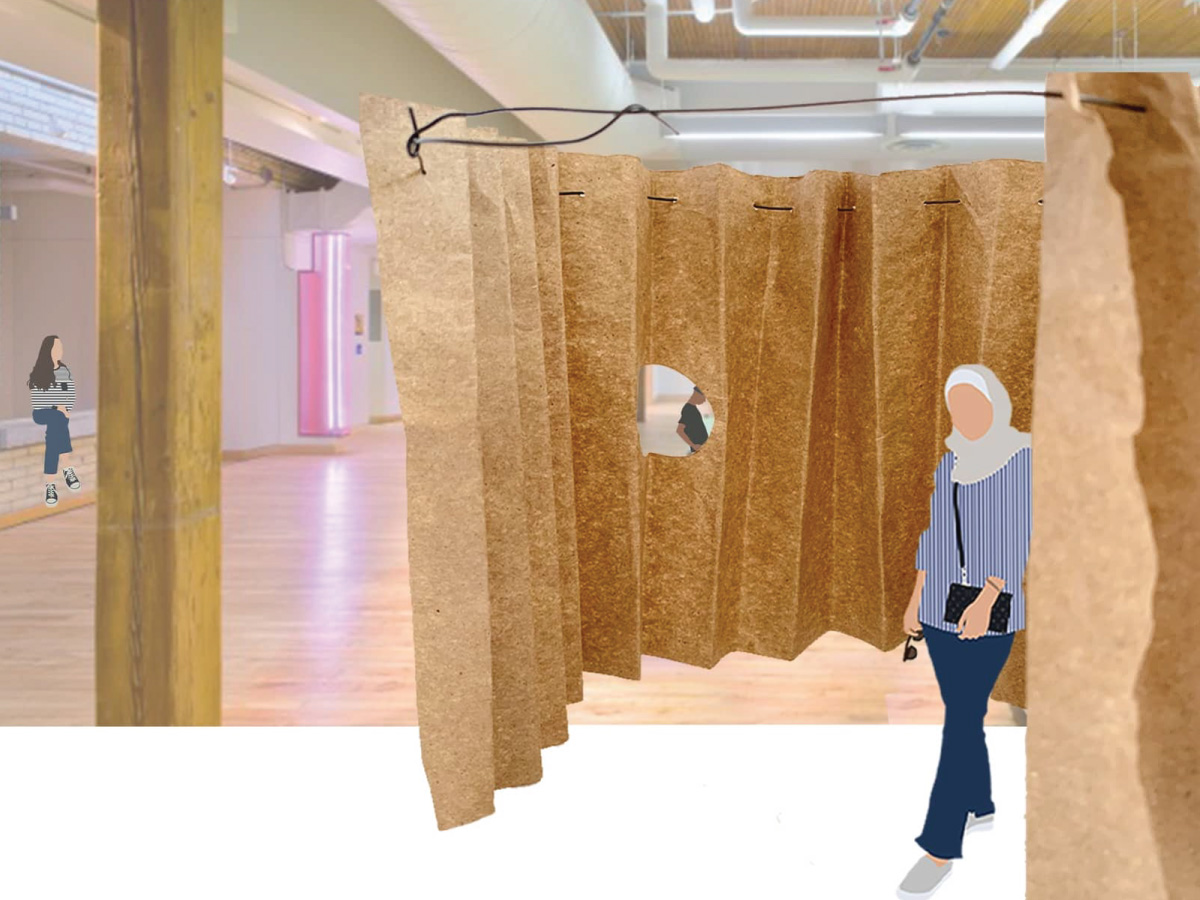Students from Fashion, Graphic Communications Management and Interior Design feature sustainable design
Students in the fashion, graphic communications management, and interior design programs explored sustainable design and practice in their creative industries and adapted to an entirely digital environment for their year-end showcases.
From upcycling fabrics and exploring environmentally friendly food packaging to reducing waste from construction sites, students used conceptual theory coupled with their own research to produce final projects that were resource-friendly, low-waste and visually high-impact.
INTRO Student Fashion Show
Every year, students in the School of Fashion showcase their work in a live runway show and exhibition. To adapt to pandemic restrictions students pivoted to a completely virtual format, displaying their fashion designs in a video and online exhibit that they produced from start to finish for the INTRO (external link, opens in new window) student fashion show.
Fashion student and INTRO producer, Nathaniel Doody, said he works to make his designs as sustainable as possible by using upcycled fabrics and materials, and sourcing only the amount of fabric he needs without excess.
“I tend to get materials on a made-to-order basis. It goes through a rigorous cycle of planning so you know exactly how much you need to reduce that waste,” Doody said. “We’re also able to source fabrics through the internal supply [at Ryerson] which stops us from having to buy new fabrics, and we can reuse old ones from all this recyclable material.”

Models pose in outfits made by Ryerson fashion students in Toronto. Courtesy of Geneva Hines
With our generation of designers, we'll see a lot more talk about sustainability and we really push that to the forefront of what we do
Doody said his peers at the Ryerson School of Fashion make it a priority to discuss how to make their designs more sustainable.
“With our generation of designers, we'll see a lot more talk about sustainability and we really push that to the forefront of what we do,” he said.
Geneva Hines, the marketing lead, videographer, and editor for INTRO, said she thought the students’ designs were creative in their use of previously owned fabrics to create a new masterpiece, all of which can be viewed as part of the INTRO virtual exhibit (external link, opens in new window) .
“For example, one of the fashion students, Alice Fu, designed her outfit with embroidered upcycled denim. Our website showcases all the designs and viewers can see how [the students] innovated and made their creations,” Hines said.

An upcycled denim outfit made by fashion student Alice Fu
GCM Virtual Thesis Expo 2020
Students enrolled in the School of Graphic Communications Management GCM 490 thesis course are required to choose a capstone topic, conduct original research and create a video to accompany the project. This year, many students in professor Ian Baitz’s class picked themes around sustainability and environmentally friendly designs for the year-end Virtual Thesis Expo (opens in new window) .
Baitz said GCM students already study sustainability in many of their courses and were motivated to apply previously learned concepts to their thesis projects.
“[These capstone projects] show that students are committed to environmental issues and want to engage in discussions in this area of their expertise,” he said. “Many in the class wanted to explore highly relevant sustainability issues relating to the pandemic, such as the explosion of packaging for food takeout and delivery, and how issues such as hygiene and package security and safety intersect with sustainability. Some explored user attitudes; others explored cutting-edge environmentally-responsible materials and life-cycle processes.”
“While we all know how important sustainability is to the future of our planet, these students really showed drive to push the limits on new solutions for a better future,” Baitz said.
Year End Show (YES) RSID
Re-vision (external link, opens in new window) , the year-end showcase put together by School of Interior Design students, focused on sustainability, equity, and a new narrative — all through the unique lens of interior design.
The showcase featured work from students in all years of the interior design program and was presented over the span of the digital festival. The final event included keynote speakers, workshops and student design projects.
YES RSID co-chairs Nehaa Rahman and Kristen Romano said sustainability has been something that is taught through all four years of the interior design program. They said the school encourages students to consistently consider sustainability in all aspects and when making all design decisions.
“We are encouraged to think about the use of materiality and ways in which we can reduce our designs' carbon footprint,” they said. “We implement sustainable qualities and aspects within our work through creating cost efficient designs, optimizing materiality choices, using efficient energy/light consumption, and conserving building resources.”
Fourth-year interior design student Elizabeth Nisbet (external link, opens in new window) , adapted sustainable practice with a concept that would reduce waste from construction projects. Nisbet’s project eliminates rigid drywall partitions that contribute to building construction waste. Her project summary explains that “the new design tackles existing thermal comfort and air-flow issues within the historic brick and beam building by introducing flexible dividers made of textile offcuts and recycled industrial plastics.”

Fourth-year interior design student Elizabeth Nisbet's final showcase project. Courtesy of YES RSID
Industry change through education
Through the INTRO (external link, opens in new window) , GCM Virtual Thesis Expo (opens in new window) and YES RSID (external link, opens in new window) year-end showcases alone, it is evident that sustainability is at the forefront of FCAD student’s design ideas and future ambitions. Environmentally-aware and sustainable practice will distinguish the next generation of design creatives who are poised to make major strides in evolving their creative industries.

The Creative School at Ryerson University
Entering its eighth decade, The Creative School is a global centre of media and creative invention. As a disrupter in innovative education, The Creative School is dedicated to developing creators with authentic voices who engage directly with creative industries around the world.
With 23 undergraduate and graduate programs that are shaping the future of their fields and tight-knit partnerships around the world, The Creative School offers more opportunities to educate the next generation of creative leaders than anywhere else.
An earlier version of this article was published prior to the faculty's rebrand and was edited to change all occurences of "FCAD" to be "The Creative School".